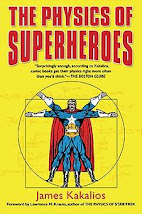The word quantum derives from Latin, meaning "how great" or "how much".[4] In quantum mechanics, it refers to a discrete unit that quantum theory assigns to certain physical quantities, such as the energy of an atom at rest. The discovery that particles are discrete packets of energy with wave-like properties led to the branch of physics dealing with atomic and sub-atomic systems which is today called quantum mechanics. It is the underlying mathematical framework of many fields of physics and chemistry, including condensed matter physics, solid-state physics, atomic physics, molecular physics, computational physics, computational chemistry, quantum chemistry,particle physics, nuclear chemistry, and nuclear physics.[5] Some fundamental aspects of the theory are still actively studied.[6]
Quantum mechanics is essential to understand the behavior of systems at atomic length scales and smaller. For example, if classical mechanics governed the workings of an atom, electrons would rapidly travel towards and collide with the nucleus, making stable atoms impossible. However, in the natural world the electrons normally remain in an uncertain, non-deterministic "smeared" (wave–particle wave function) orbital path around or through the nucleus, defying classical electromagnetism.[7]
Quantum mechanics was initially developed to provide a better explanation of the atom, especially the differences in the spectra of lightemitted by different isotopes of the same element. The quantum theory of the atom was developed as an explanation for the electron remaining in its orbit, which could not be explained by Newton's laws of motion and Maxwell's laws of classical electromagnetism.
Broadly speaking, quantum mechanics incorporates four classes of phenomena for which classical physics cannot account:
Lecture 5 of Leonard Susskind's Modern Physics course concentrating on Quantum Mechanics. Recorded February 11, 2008 at Stanford University.
This Stanford Continuing Studies course is the second of a six-quarter sequence of classes exploring the essential theoretical foundations of modern physics. The topics covered in this course focus on quantum mechanics. Leonard Susskind is the Felix Bloch Professor of Physics at Stanford University.
Complete playlist for the course:
http://youtube.com/view_play_list?p=189C0DCE90CB6D81
Stanford Continuing Studies: http://continuingstudies.stanford.edu/
Stanford University channel on YouTube:
http://www.youtube.com/stanford
Kategori:
- Course material
- Doron Cohen: Lecture notes in Quantum Mechanics (comprehensive, with advanced topics).
- MIT OpenCourseWare: Chemistry.
- MIT OpenCourseWare: Physics. See 8.04
- Stanford Continuing Education PHY 25: Quantum Mechanics by Leonard Susskind, seecourse description Fall 2007
- 5½ Examples in Quantum Mechanics
- Imperial College Quantum Mechanics Course.
- Spark Notes - Quantum Physics.
- Quantum Physics Online : interactive introduction to quantum mechanics (RS applets).
- Experiments to the foundations of quantum physics with single photons.
- Motion Mountain, Volume IV - A modern introduction to quantum theory, with several animations.
- AQME : Advancing Quantum Mechanics for Engineers — by T.Barzso, D.Vasileska and G.Klimeck online learning resource with simulation tools on nanohub
- Quantum Mechanics by Martin Plenio
- Quantum Mechanics by Richard Fitzpatrick
- Online course on Quantum Transport






